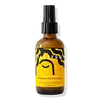What's inside
What's inside
 Key Ingredients
Key Ingredients

No key ingredients
 Benefits
Benefits

 Concerns
Concerns

 Ingredients Side-by-side
Ingredients Side-by-side

Glycine Soja Oil
EmollientRicinus Communis Seed Oil
MaskingRosmarinus Officinalis Leaf Oil
MaskingSimmondsia Chinensis Seed Oil
EmollientMentha Piperita Oil
MaskingEucalyptus Globulus Leaf Oil
PerfumingMenthol
MaskingMelaleuca Alternifolia Leaf Oil
AntioxidantCocos Nucifera Oil
MaskingEquisetum Arvense Extract
AstringentAloe Barbadensis Extract
Skin ConditioningLavandula Angustifolia Oil
MaskingTriticum Vulgare Germ Oil
EmollientCarthamus Tinctorius Seed Oil
MaskingOenothera Biennis Oil
EmollientVitis Vinifera Seed Oil
EmollientBenzyl Nicotinate
Skin ConditioningPrunus Amygdalus Dulcis Oil
Skin ConditioningOryza Sativa Bran Oil
EmollientTocopheryl Acetate
AntioxidantBiotin
AntiseborrhoeicArctium Lappa Root Extract
Skin ConditioningGlycerin
HumectantApium Graveolens Seed Extract
AntioxidantRetinyl Palmitate
Skin ConditioningCholecalciferol
Ascorbic Acid
AntioxidantOcimum Basilicum Oil
MaskingPogostemon Cablin Leaf Oil
MaskingSalvia Officinalis Oil
MaskingSilica
AbrasiveUrtica Dioica Extract
AstringentGlycine Soja Oil, Ricinus Communis Seed Oil, Rosmarinus Officinalis Leaf Oil, Simmondsia Chinensis Seed Oil, Mentha Piperita Oil, Eucalyptus Globulus Leaf Oil, Menthol, Melaleuca Alternifolia Leaf Oil, Cocos Nucifera Oil, Equisetum Arvense Extract, Aloe Barbadensis Extract, Lavandula Angustifolia Oil, Triticum Vulgare Germ Oil, Carthamus Tinctorius Seed Oil, Oenothera Biennis Oil, Vitis Vinifera Seed Oil, Benzyl Nicotinate, Prunus Amygdalus Dulcis Oil, Oryza Sativa Bran Oil, Tocopheryl Acetate, Biotin, Arctium Lappa Root Extract, Glycerin, Apium Graveolens Seed Extract, Retinyl Palmitate, Cholecalciferol, Ascorbic Acid, Ocimum Basilicum Oil, Pogostemon Cablin Leaf Oil, Salvia Officinalis Oil, Silica, Urtica Dioica Extract
 Reviews
Reviews

Ingredients Explained
These ingredients are found in both products.
Ingredients higher up in an ingredient list are typically present in a larger amount.
Carthamus tinctorius seed oil comes from safflower, one of humanity's oldest crops.
Safflower seed oil contains a high percentage of linoleic acid and oleic acid. It also contains Vitamin E. These three components are effective moisturizers.
Vitamin E helps nourish your skin's lipid barrier. It is also a potent antioxidant. Antioxidants help fight free-radical molecules, or unstable molecules that may damage your skin cells.
Due to its high fatty acid content, this ingredient may not be malassezia folliculitis safe.
Thoughout history, safflower has been used for dying fabrics and in food as a saffron substitute.
Learn more about Carthamus Tinctorius Seed OilLavandula Angustifolia Oil is more commonly known as lavender essential oil. It is considered a fragrancing ingredient.
Lavender imparts a famous scent. While the smell is lovely, this ingredient and may sensitize skin in topical products. This is because about 85% of the oil is made up of linalool and linalyl acetate.
When exposed to air, these two compounds become strong allergens. This ingredient exhibits cytotoxicity at low concentrations; amounts of 0.25% have been shown to damage skin cells.
A study from Japan found this ingredient caused lavender sensitivity after widespread exposure.
Lavender essential oil has some antimicrobial, antibacterial, and anti-inflammatory properties. However, the cons of this ingredient may outweight the pros.
More research is needed to confirm lavender essential oil's effects when used in aromatherapy.
Lavandula Angustifolia is known as the English Lavender and famous for creating purple fields in Provence, France.
Learn more about Lavandula Angustifolia OilThis oil comes from the seeds of the desert shrub called Jojoba. It is more commonly known as jojoba oil, a non-comedogenic oil.
Jojoba oil does not contain fragrance and has many fatty-acids, making it a great soothing ingredient.
It also contains Vitamin E, a great moisturizing ingredient. Vitamin E is also an antioxidant and protects your skin against oxidative damage.
This ingredient humectant properties, meaning it helps draw moisture from the air. This helps keep your skin hydrated.
While jojoba has antibacterial properties, it is only able to kill some strains of bacteria.
Studies also show it helps in wound healing. In fact, Indigenous cultures have used jojoba as a moisturizer and to help treat burns for centuries.
Fun fact: Jojoba oil similar to natural human skin sebum, so it has a great effect on dry skin. It is also promising with helping to regulate sebum production.
Due to its fatty acid content, Jojoba oil may not be fungal acne safe. We recommend speaking with a professional if you have any concerns.
Learn more about Simmondsia Chinensis Seed Oil